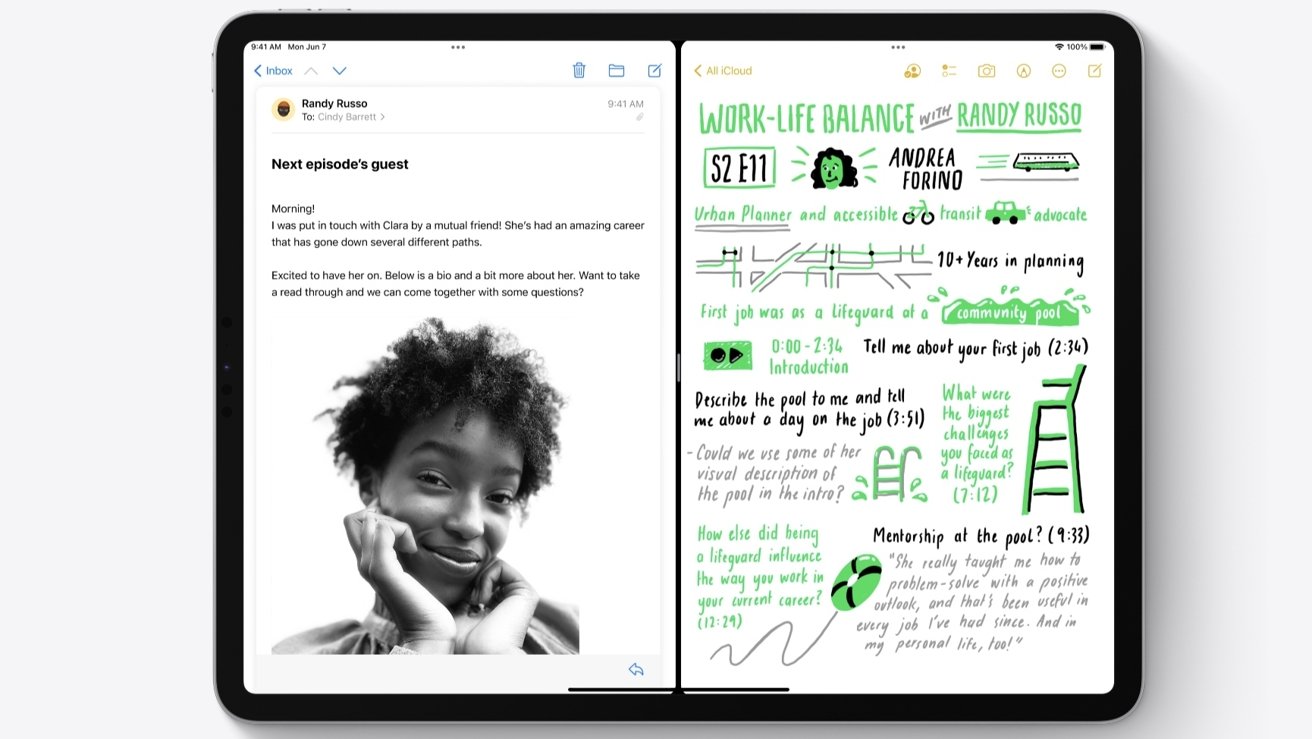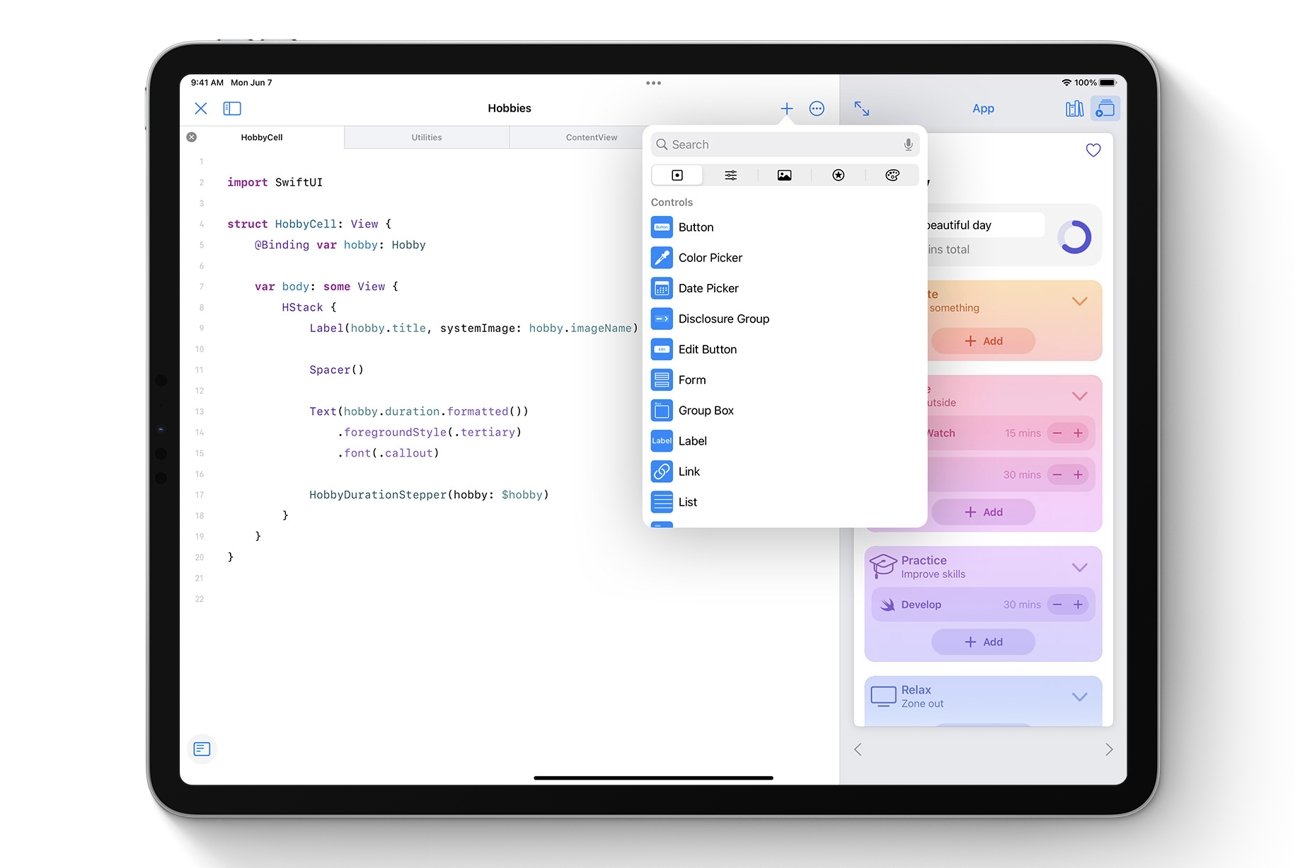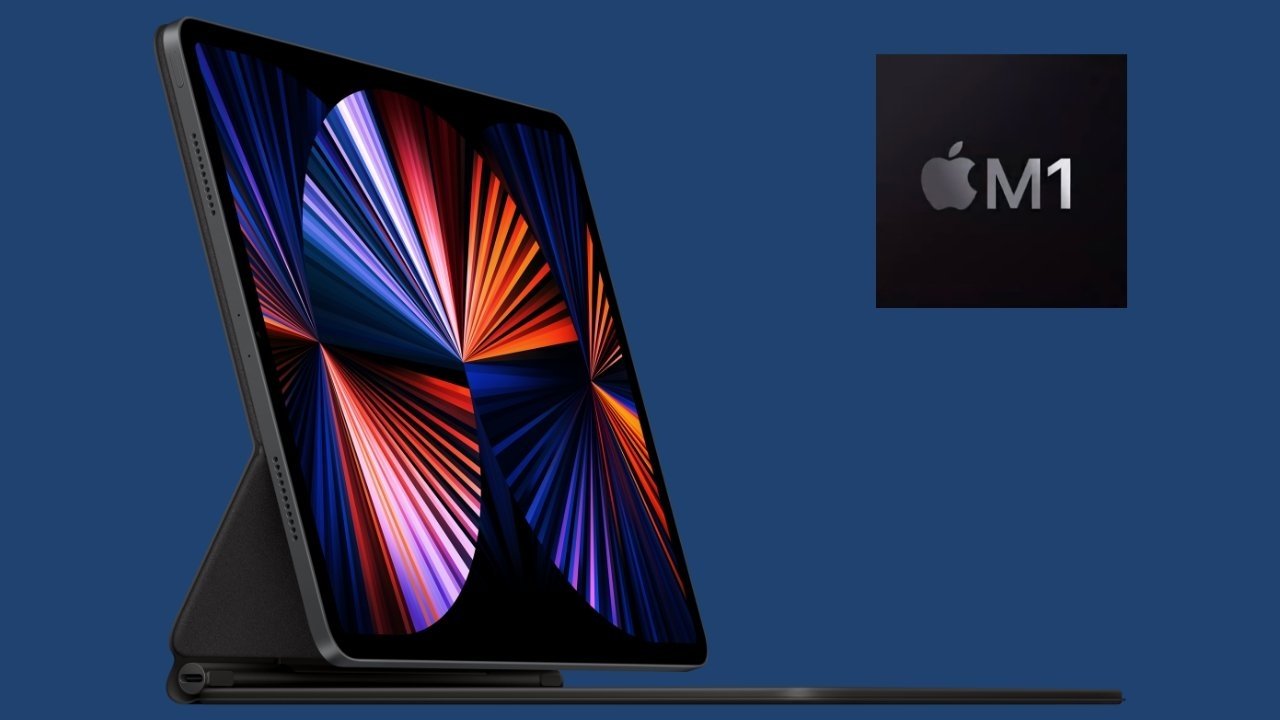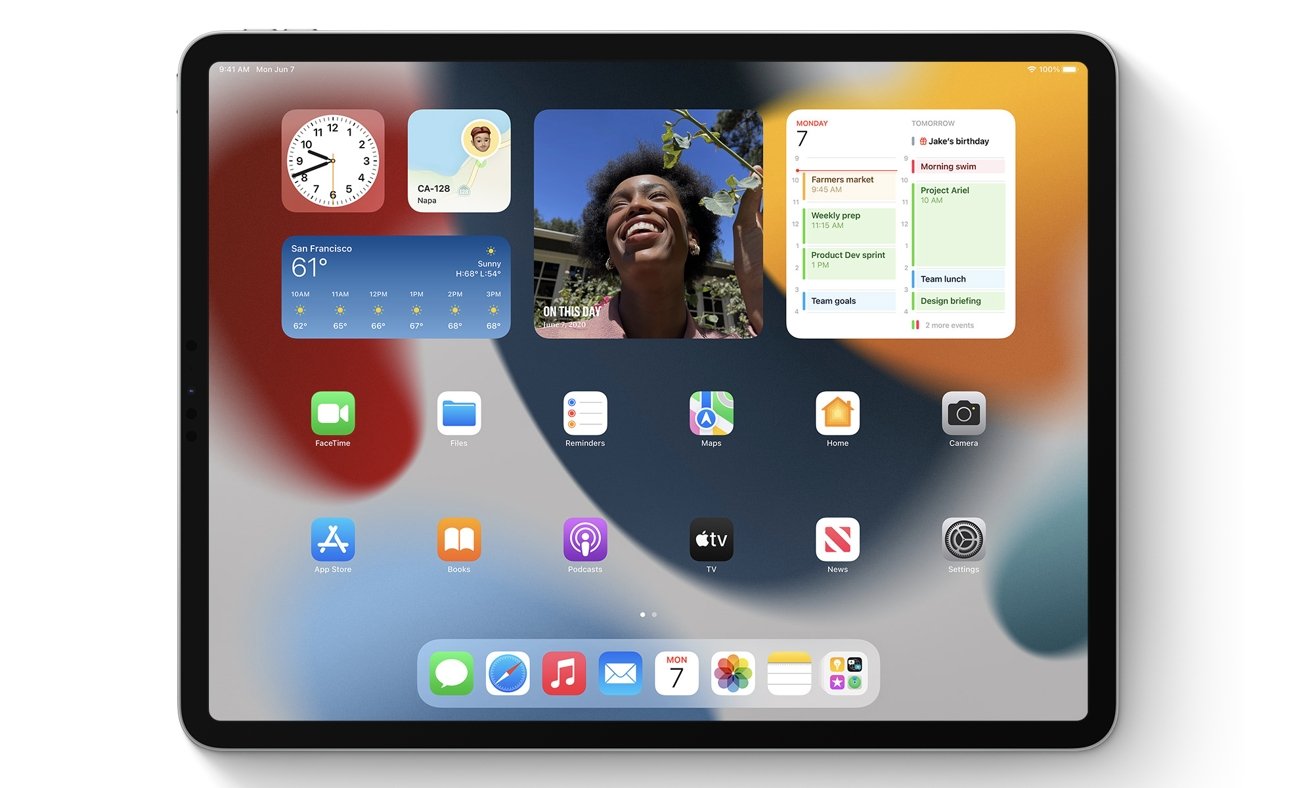iPadOS 15 confirms Apple's M1-equipped iPad Pro is a V8 engine powering a Ford Pinto
The hardware on the new iPad Pro is absolutely stellar, far beyond any competition in the tablet space. But, Apple's newly announced iPadOS 15 is so decidedly not-pro that it's fair to question whether the company will ever fully take the training wheels off of its restrictive software.

Following the launch of new iPad Pro models in May, which feature the same blazing fast M1 CPU as Apple's latest Mac systems, many predicted and hoped that the device maker would unveil an overhauled iPadOS at its Worldwide Developers Conference.
There remains a lot of low-hanging fruit that the company could have tackled -- features already widely available on both Intel and M1 Macs, including a more robust multitasking system, proper support for external monitors, and greater compatibility with external peripherals.
We didn't get any of those.
Instead, the headline features include:
There is so much powerful hardware in the svelte iPad Pro design, so much untapped potential, that users and developers alike have been clamoring for an overhaul of iPadOS to truly unlock its potential for high-performance users.

Though it has a USB-4/Thunderbolt 3 port, the new iPad Pro does not offer full support for external monitors. On the home screen and throughout the native operating system, the iPad will simply mirror what is displayed on the iPad. Have a widescreen 16:9 display? Too bad, you get a 4:3 ratio matching what your iPad is already showing you.
Again, there is no technical reason for this limitation based on the hardware in the new iPad Pro, or even in the previous-generation models. Every M1 Mac is capable of driving an external display at its native resolution. This shortcoming is simply a limitation of iPadOS, and it's not addressed in the upcoming version 15 upgrade.
That USB-4 port is also hobbled when it comes to inputs. Any podcaster who does shows with remote hosts knows if you want to use an external microphone, you'll need at least one app for live communication with the others appearing on the program, and another app to record your local audio at the highest possible quality. This is impossible with iPadOS, including the upcoming version 15, as only one app at a time can tap into incoming audio from an external microphone.

What about pro apps? Developers have been clamoring for Xcode, Apple's integrated software development environment currently limited to macOS, to make the migration over to the iPad. After all, now that the iPad supports keyboards and mouse/trackpad input, there is no real reason to not have Xcode for iPad Pro.
But instead of Xcode, Apple essentially gave developers a slap in the face, introducing an improved version of Swift Playgrounds -- an educational tool created to help children learn how to code -- that will allow iPad users to write and submit apps to the App Store. A pro app, Swift Playgrounds is not.
Finally, multitasking on iPad Pro -- which is to say, displaying two or more apps on the screen simultaneously -- has been a confusing mess for years, to put it charitably. It very clearly needs a reimagining from the ground up.
Instead, with iPadOS 15, Apple simplified the current system by adding dedicated buttons that will allow users to more easily invoke features like Split View, or making a split app fullscreen once again. Rather than go back to the drawing board and fix the problem with a better, more robust solution worthy of pros who probably use dozens of apps simultaneously, the company simply added a few buttons to the existing system and called it a day.
The pandemic and remote working has made it challenging for teams of all sizes at all kinds of companies to be as productive and efficient as they once were. It's possible that Apple had grand ambitions for iPadOS this year, but simply wasn't able to meet them because its workers, its corporate culture, and its need to update all of its major platforms and services on an annual basis proved to be too much.
It's still baffling that the new iPad Pro has an M1 processor identical to the one found in Macs but lacks basic computing features. One potential explanation for why Apple put the M1 in the iPad might simply be chip consolidation.

Viewed from one angle, with an ongoing chip shortage driven by the pandemic, Apple may have decided it made sense to use one chip to rule them all, making it easier to mass-produce all of its popular devices by relying on the same brains for each model.
But from another, more pessimistic view, placing the M1 in the iPad Pro could be a supply chain consolidation tactic for financial reasons, increasing efficiency and thus improving margins to help Apple's bottom line.
The third -- and most optimistic -- view on the situation might be that Apple is planning future updates to iPadOS that will take advantage of what the M1 has to offer. This feels possible, but also makes it clear that anyone splurging for a $1800 12.9-inch iPad Pro with 16 gigabytes of RAM is getting hosed for the foreseeable future, in hopes that maybe one day that the software on their super-powered tablet might live up to its hardware potential.
Apple's iPadOS will inevitably continue to mature, and Apple would be foolish not to bring apps like Xcode, Final Cut, Logic and other professional-grade software to its beast of a tablet.
After Apple's WWDC keynote this week, I lamented on Twitter that the iPadOS 15 unveiling was a disappointment. One reader responded that WWDC is meant for developers, not users, and apps like Final Cut and Logic make more sense to unveil in the fall.
That wishful thinking may ultimately prove to be true, but it's important to remember that many of the headline features unveiled with iPadOS 15 have very little to do, specifically, with developers.
Sure, widgets placeable anywhere on the home screen will encourage more developers to make widgets -- but those widgets have been a part of iPadOS (relegated to the left side of the screen, or on the search screen) for years. The addition of App Library, ported over from the iPhone, has essentially no consequences for developers. Quick Notes, SharePlay, screen sharing and new Memoji are all features Apple chose to showcase for iPadOS 15, and they have almost nothing to do with developers. WWDC may be a developer-focused show, but the keynote is intended for everyone.

I love my 12.9-inch iPad Pro, and I use it every single day. It's an invaluable tool in my arsenal, and that's why I so desperately want to see it live up to its full potential.
But after WWDC 2021 and the iPadOS 15 unveiling, I'm wondering if Apple really ever wants it to live up to that potential. Or maybe they'd rather just sell you a Mac for that stuff.
If that's the case, so be it. I'll happily plunk down for a new 12.9-inch iPad Pro with 8 gigabytes of RAM, and spend that extra change to put more horsepower into Apple's alternative platform -- one that can actually take advantage of all of the hardware under the hood.
Follow all the details of WWDC 2021 with the comprehensive AppleInsider coverage of the whole week-long event from June 7 through June 11, including details of all the new launches and updates.
Stay on top of all Apple news right from your HomePod. Say, "Hey, Siri, play AppleInsider," and you'll get latest AppleInsider Podcast. Or ask your HomePod mini for "AppleInsider Daily" instead and you'll hear a fast update direct from our news team. And, if you're interested in Apple-centric home automation, say "Hey, Siri, play HomeKit Insider," and you'll be listening to our newest specialized podcast in moments.

Following the launch of new iPad Pro models in May, which feature the same blazing fast M1 CPU as Apple's latest Mac systems, many predicted and hoped that the device maker would unveil an overhauled iPadOS at its Worldwide Developers Conference.
There remains a lot of low-hanging fruit that the company could have tackled -- features already widely available on both Intel and M1 Macs, including a more robust multitasking system, proper support for external monitors, and greater compatibility with external peripherals.
We didn't get any of those.
Instead, the headline features include:
- New buttons to invoke the same old multitasking system -- an improvement, but not the overhaul needed
- Widgets that can be placed anywhere on the home screen -- something that launched a year ago on the iPhone
- The ability to quickly scribble notes while in an app -- something that could previously be done by tapping the lock screen with an Apple Pencil.
There is so much powerful hardware in the svelte iPad Pro design, so much untapped potential, that users and developers alike have been clamoring for an overhaul of iPadOS to truly unlock its potential for high-performance users.

Souped up, but only driving in a school zone
Consider that the new iPad Pro, for the first time ever, comes with options of 8 or 16 gigabytes of RAM, bringing it even more in line with the Mac. When the M1 iPad Pro went on sale, developers noted that apps were limited to 5 gigabytes of RAM in iPadOS 14, leading to expectations that more power would be made available to developers with iPadOS 15. Yet at this week's WWDC, there has been no indication that developers are being provided the tools they need to take their professional-grade iPad apps to the next level.Though it has a USB-4/Thunderbolt 3 port, the new iPad Pro does not offer full support for external monitors. On the home screen and throughout the native operating system, the iPad will simply mirror what is displayed on the iPad. Have a widescreen 16:9 display? Too bad, you get a 4:3 ratio matching what your iPad is already showing you.
Again, there is no technical reason for this limitation based on the hardware in the new iPad Pro, or even in the previous-generation models. Every M1 Mac is capable of driving an external display at its native resolution. This shortcoming is simply a limitation of iPadOS, and it's not addressed in the upcoming version 15 upgrade.
That USB-4 port is also hobbled when it comes to inputs. Any podcaster who does shows with remote hosts knows if you want to use an external microphone, you'll need at least one app for live communication with the others appearing on the program, and another app to record your local audio at the highest possible quality. This is impossible with iPadOS, including the upcoming version 15, as only one app at a time can tap into incoming audio from an external microphone.

What about pro apps? Developers have been clamoring for Xcode, Apple's integrated software development environment currently limited to macOS, to make the migration over to the iPad. After all, now that the iPad supports keyboards and mouse/trackpad input, there is no real reason to not have Xcode for iPad Pro.
But instead of Xcode, Apple essentially gave developers a slap in the face, introducing an improved version of Swift Playgrounds -- an educational tool created to help children learn how to code -- that will allow iPad users to write and submit apps to the App Store. A pro app, Swift Playgrounds is not.
Finally, multitasking on iPad Pro -- which is to say, displaying two or more apps on the screen simultaneously -- has been a confusing mess for years, to put it charitably. It very clearly needs a reimagining from the ground up.
Instead, with iPadOS 15, Apple simplified the current system by adding dedicated buttons that will allow users to more easily invoke features like Split View, or making a split app fullscreen once again. Rather than go back to the drawing board and fix the problem with a better, more robust solution worthy of pros who probably use dozens of apps simultaneously, the company simply added a few buttons to the existing system and called it a day.
What exactly is going on?
Why is it this way? There are a few possible explanations.The pandemic and remote working has made it challenging for teams of all sizes at all kinds of companies to be as productive and efficient as they once were. It's possible that Apple had grand ambitions for iPadOS this year, but simply wasn't able to meet them because its workers, its corporate culture, and its need to update all of its major platforms and services on an annual basis proved to be too much.
It's still baffling that the new iPad Pro has an M1 processor identical to the one found in Macs but lacks basic computing features. One potential explanation for why Apple put the M1 in the iPad might simply be chip consolidation.

Viewed from one angle, with an ongoing chip shortage driven by the pandemic, Apple may have decided it made sense to use one chip to rule them all, making it easier to mass-produce all of its popular devices by relying on the same brains for each model.
But from another, more pessimistic view, placing the M1 in the iPad Pro could be a supply chain consolidation tactic for financial reasons, increasing efficiency and thus improving margins to help Apple's bottom line.
The third -- and most optimistic -- view on the situation might be that Apple is planning future updates to iPadOS that will take advantage of what the M1 has to offer. This feels possible, but also makes it clear that anyone splurging for a $1800 12.9-inch iPad Pro with 16 gigabytes of RAM is getting hosed for the foreseeable future, in hopes that maybe one day that the software on their super-powered tablet might live up to its hardware potential.
Apple's iPadOS will inevitably continue to mature, and Apple would be foolish not to bring apps like Xcode, Final Cut, Logic and other professional-grade software to its beast of a tablet.
After Apple's WWDC keynote this week, I lamented on Twitter that the iPadOS 15 unveiling was a disappointment. One reader responded that WWDC is meant for developers, not users, and apps like Final Cut and Logic make more sense to unveil in the fall.
That wishful thinking may ultimately prove to be true, but it's important to remember that many of the headline features unveiled with iPadOS 15 have very little to do, specifically, with developers.
Sure, widgets placeable anywhere on the home screen will encourage more developers to make widgets -- but those widgets have been a part of iPadOS (relegated to the left side of the screen, or on the search screen) for years. The addition of App Library, ported over from the iPhone, has essentially no consequences for developers. Quick Notes, SharePlay, screen sharing and new Memoji are all features Apple chose to showcase for iPadOS 15, and they have almost nothing to do with developers. WWDC may be a developer-focused show, but the keynote is intended for everyone.

If this is it, please let me know
It's possible that this is all Apple ever intends for the iPad to be -- a powerful, capable, delightful device with a host of great apps designed for unitasking with occasional multitasking. Those who need to use dual monitors, record a podcast, or edit 4K video with surround sound audio should get a Mac. Macs are pretty good at all of that stuff, and the M1 is great.I love my 12.9-inch iPad Pro, and I use it every single day. It's an invaluable tool in my arsenal, and that's why I so desperately want to see it live up to its full potential.
But after WWDC 2021 and the iPadOS 15 unveiling, I'm wondering if Apple really ever wants it to live up to that potential. Or maybe they'd rather just sell you a Mac for that stuff.
If that's the case, so be it. I'll happily plunk down for a new 12.9-inch iPad Pro with 8 gigabytes of RAM, and spend that extra change to put more horsepower into Apple's alternative platform -- one that can actually take advantage of all of the hardware under the hood.
Follow all the details of WWDC 2021 with the comprehensive AppleInsider coverage of the whole week-long event from June 7 through June 11, including details of all the new launches and updates.
Stay on top of all Apple news right from your HomePod. Say, "Hey, Siri, play AppleInsider," and you'll get latest AppleInsider Podcast. Or ask your HomePod mini for "AppleInsider Daily" instead and you'll hear a fast update direct from our news team. And, if you're interested in Apple-centric home automation, say "Hey, Siri, play HomeKit Insider," and you'll be listening to our newest specialized podcast in moments.



Comments
If the iPad Pro is supposed to be a “computer”, Apple needs to prove it. In many ways, it supports the need of 90% of the audience using the device. For that crucial 10% though, there are huge gaps in the ability to drive creative (and non-creative) workflows even further.
Finally, the bit about the pandemic is valid, although there are tech companies thriving in remote working sessions and have seen their revenues and collaboration scale to new levels. I find this point difficult to digest as the company that I work for has had an incredible year in development all while being remote.
Hopefully, this all gets rectified in the coming months and the main complaints are addressed. Otherwise, it would have been a wasted investment for many of us where we probably should have just stuck with our 2018 or 2020 devices.
It’s up to the developer to figure out his costs and price the app accordingly, and users shouldn’t have to pay extra because the app runs on one hardware or another. You don’t buy separate licenses for “full screen mode” apps, laptop apps, desktop apps, etc.
An iOS version is simply another display mode for the same code, one would hope, and not a toy version of the app, at least not in 2021 on an M1
It's policy that prevents OSX from running on the new iPad Pro. Apple wants to keep the iPad locked down and secure.
Everything else, like watching Netflix in bed, jotting down a note, or quickly checking an e-mail, are fringe benefits. Despite the latest iPad of mine being a 12” A12X based iPad Pro with 1TB of storage, it NEVER was more for me than a photo album and media consumption device, and certainly NOTHING that deserved the name Pro, not even for something as trivial as e-mail does it deserve that name, for what sort of “Pro” solution is an e-mail system that doesn’t allow the user to inspect a messages RAW content to see if something is real or an elaborate phishing e-mail? At best, it might qualify as a semi-pro accessory to a Mac, if one uses it as a Wacom Tablet replacement with Sidecar or some third party software like AirDisplay.
When the MagicKeyboard hit the market, it endeavored into an expensive experiment: would a MagicKeyboard change how I worked with the iPad Pro? Would a cigarette box sized Raspberry Pi 8GB RAM Linux system attached, networked and powered over the USB-C connection and operated over RDP, make up for some of the shortcomings of iPad OS (e.g. by running a real e-mail client like Thunderbird on the Raspberry, by having Mathematica on the Raspberry, by having development and network testing tools on the linux system, etc.)?
The answer was a resounding YES in both cases, but more importantly, it showed me that the iPad Pro with MagicKeyboard was the HARDWARE I always wished a MacBook Air would be: Much better screen, touch screen, pen input, etc. At the same time, the more I worked with the MagicKeyboard, the more painful the shortcomings of iPadOS became.
Yes, I get the difference between a mouse/trackpad&keyboard driven UI and a touch UI. I get that macOS is the former and iPadOS is the latter…
…BUT, branding aside, macOS and iPadOS are fundamentally the same OS (Darwin), with different UI layers. With the new iPad Pros (A12X and up with 6GB RAM or more) there is no hardware issue with running macOS. And just as macOS apps can have a windowed mode and a full screen mode, there’s nothing that stops the same app from in addition having a touch UI mode. So one could have an adaptive OS, which adjusts the UI based on whether docked with pointing device and keyboard, or used standalone in touch UI mode.
With the M1 version, and its up to 2TB of SSD and 16GB RAM, there could be even another solution: virtualization. Run macOS virtualized in an iPadOS app, and switch to it when docked, and suspend it when undocked.
Even working on a slow-poke system like a Raspberry Pi “remotely” over USB-C and RDP makes the iPad Pro feel like a seamless laptop, that lets me miss nothing (except for macOS rather than Linux), so how much better would a virtualized macOS be, that would run at nearly native speed, and would gain tablet input, and instant switching between iPadOS and macOS? How cool would it be to run Xcode on the virtualized macOS system, and then test the app directly on the iPad?
It would be awesome, beyond words. And what would Apple have to do to make this possible? Nothing. Less than nothing. All they would need to do is to stop actively sabotaging virtualization apps on iPadOS, and a third party solution would spring up in short order.
Now, why is Apple getting in its own way?
The answer is easy: they don’t have “software and hardware divisions”, which if they did, they wouldn’t care which of their operating systems you ran on which of their hardware devices, but they have “Mac, iDevice, aTV, etc. divisions”, and so the Mac division has no interest in driving iDevice sales by spending man hours making their software available on the competing division’s hardware, while digging their own hardware’s grave. The video of how the iPad division went to steal the M1 chip from the Mac division, was in a strange way revealing of why we have the problems as Pro users with the iPad Pro and its media consumption platform operating system.
As to your second point, the A12 chips in the prior iPads were used in the developer transition kit to run an ARM build of macOS (with its much deeper multi-tasking and windowing support), and the chip ran macOS just fine. Clearly they have enough horsepower. So I highly doubt that if Apple added the changes requested here in this article that the 2018 and 2020 iPad Pros would be rendered obsolete.
Until Apple makes fundamental changes to iPadOS, the M1 chip is a waste of hardware honestly. The A12z in the 2020 version is just fine. The only real difference with M1 is the addition of thunderbolt so you can connect to peripherals like 10gbps lan cards, high speed storage, etc. But other than that, there’s nothing about the iPadOS experience that is significantly different on M1 vs the A12x/A12z. Multi monitor support is still limited to 4x3 and does not scale to the 16x9 or 16x10 aspect ratio of monitors. iPadOS has some fundamental limitations, even though the hardware itself has been proven to not be limited in that regard, as M1 and A12x/A12z can run the more complicated window manager of macOS. And we have to tell the truth.
It’s a little odd that we should be anxious over a processor that is too powerful for the tasks intended.
As long as it does not materially effect the price of the product I see no harm in slimming down the number of different processors in Apples product range. It may even be that the minimum wafer quantities of the M1 dictate their use in more products that just Macs.
When there is a major version number change, I expect big changes. iPadOS 15 has been in the works for quite a while. Apple had plenty of time to design it to utilize the power of the M1 platform. Instead we get pretty much nothing. I think that is the point being made here.